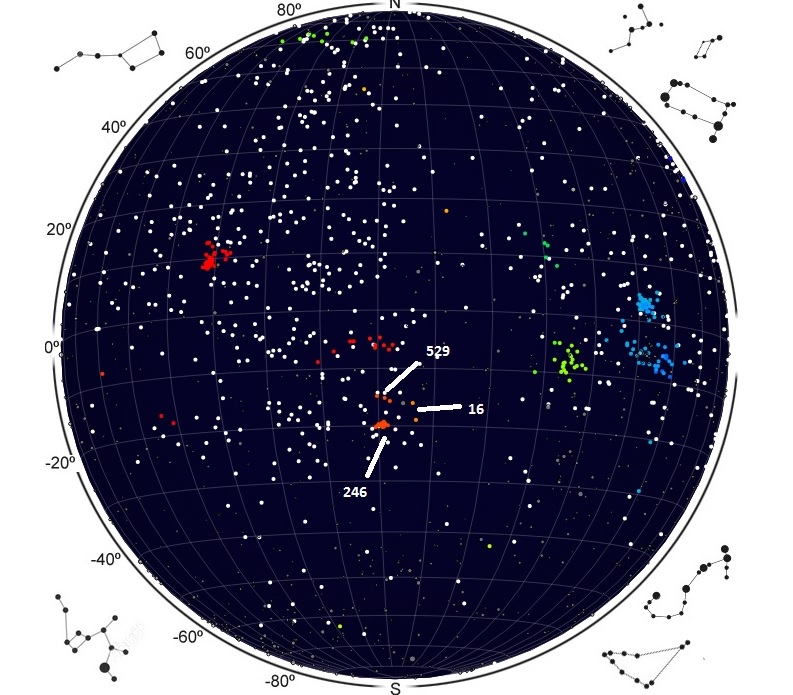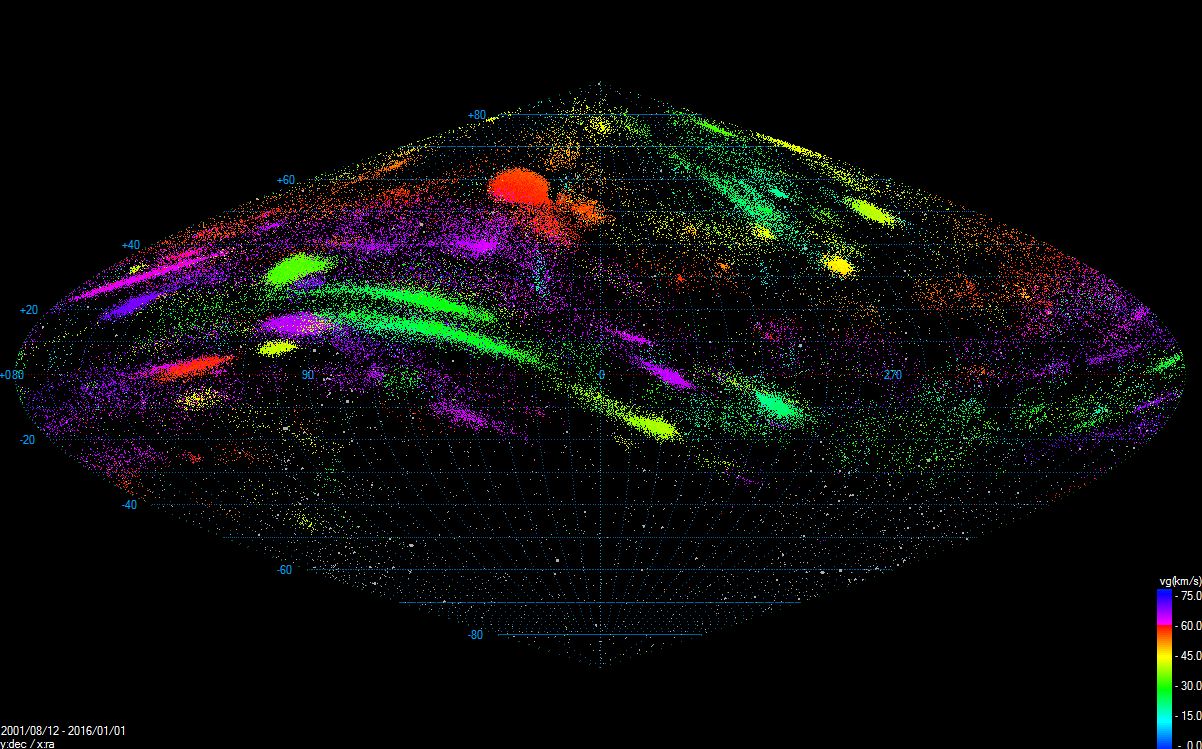By Paul Roggemans, Carl Johannink and Jean-Marie Biets
17 orbits of the annual component of the Alpha Monocerotids (246 AMO) were captured by CAMS networks between 21 and 24 November, 10 of them in the United Arab Emirates on 21 November between 21h to 24h UT.
1 Introduction
The Alpha Monocerotids (AMO-246) are a poorly known meteor stream which must be related to a so far unknown long periodic comet. This shower caught attention because of short outbursts of activity in 1925, 1935, 1985 and 1995, the 1995 outburst being predicted and well observed by different observers in Europe.
The shower analyses of over 110000 orbits obtained by the CAMS project between October 2010 and March 2013 did not reveal any single orbit for this shower (Jenniskens et al., 2016). The IAU meteor shower list has the orbit of the Alpha Monocerotids based on as few as 10 orbits obtained during the 1995 outburst (Jenniskens et al., 1997). Any additional data about this shower would be very welcome.
2 1995 AMO outburst
Peter Jenniskens had predicted a possible outburst for this shower on 1995 November 22 (Jenniskens, 1995). The outburst did effectively occur on November 22, at 1h29m UT corresponding to solar longitude 239.32° (epoch 2000.0). The annual component of this shower is believed to display a zenithal hourly rate of 5 per hour at best; nevertheless CAMS did not manage to capture any single AMO orbit in the years 2010, 2011 or 2012.
3 2017 observations
No outburst was expected, a possible next outburst may occur in 2043, although there is also a small chance in 2019 (Jenniskens, 2006). However, with more network capacity there is always hope to catch some more orbits for the annual component of this stream. Hence it wasn’t a complete surprise that the CAMS networks captured some Alpha Monocerotids during 2017.
Up to today, as many as 17 Alpha Monocerotid orbits have been identified from data by the different CAMS networks in 2017. Most of these orbits were obtained by CAMS in the United Arab Emirates.
Table 1 – Radiant position, beginning and ending height and the orbit for the annual component of the AMOs as well as for the 1995 dust trail (Jenniskens et al., 1997). The CAMS BeNeLux AMO orbit was obtained on 23 November at 5h48m52s UT by CAMS 382 and CAMS 399.
| Annual component | Outburst 1995 | CAMS BeNeLux 2017 | |
| RA | 117.53±0.05 | 117.10±0.13 | 119.3±0.1 |
| Decl | +1.18 ± 0.05 | +0.83±0.16 | +0.1±0.1 |
| Vinf | 63.6±0.4 | 64.0±0.2 | 61.6 km/s (Vg) |
| Hb | 97.5 km | 110.10±0.05 km | |
| He | 84.1 km | 98.80±0.05 km | |
| q | 0.485 | 0.488±0.019 | 0.487±0.003 |
| i | 138.18 | 134.13±0.34 | 133.5±0.2 |
| ω | 91.25 | 90.66±0.78 | 92.571 |
| Ω | 59.425 | 59.322±0.4 | 60.886 |
The first AMO was recorded by the United Arab Emirates CAMS network on 21 November (λʘ = 238.679°) and the second by the Lowell Observatory CAMS network in Arizona at λʘ = 239.053°. The CAMS BeNeLux network had totally overcast sky during this night. The next night, 21–22 November, 10 AMO orbits were obtained around λʘ ~239.57° by the United Arab Emirates CAMS network on a total of 127 orbits obtained that night by this network (see Figure 1). The CAMS BeNeLux network had totally overcast sky during this night. The CAMS network in California got 2 AMO orbits at λʘ ~ 240.035° on a total of 247 orbits and the CAMS BeNeLuX network got 1 AMO orbit at λʘ = 240.895°on a total of 320 orbits for that night. CAMS California got an AMO at λʘ = 240.991° and the last AMO was for the Lowell Observatory CAMS network in Arizona at λʘ = 241.146°. The weather circumstances were less favorable except for the United Arab Emirates.
References
Jenniskens P. (1995). “Good Prospects for alpha-Monocerotid Outburst in 1995”. WGN, Journal of the International Meteor Organization, 23, 84–86.
Jenniskens P., Betlem H., de Lignie M. and Langbroek M. (1997). “The detection of a dust trail in the orbit of an Earththreatening long-period comet”. Astrophys. J., 479, 441–447.
Jenniskens P. (2006). “Meteor Showers and their Perent Comets”. Pages 617-618.
Jenniskens P., Gural P. S., Dynneson L., Grigsby B. J., Newman K. E., Borden M., Koop M. and Holman D. (2011). “CAMS: Cameras for Allsky Meteor Surveillance to establish minor meteor showers”. Icarus, 216, 40–61.
Jenniskens P., Nénon Q., Albers J., Gural P. S., Haberman B., Holman D., Morales R., Grigsby B. J., Samuels D. and Johannink C. (2016). “The established meteor showers as observed by CAMS”. Icarus, 266, 331–354.







